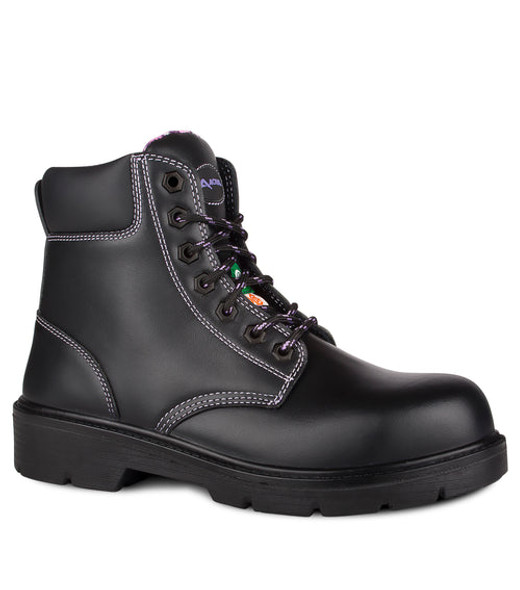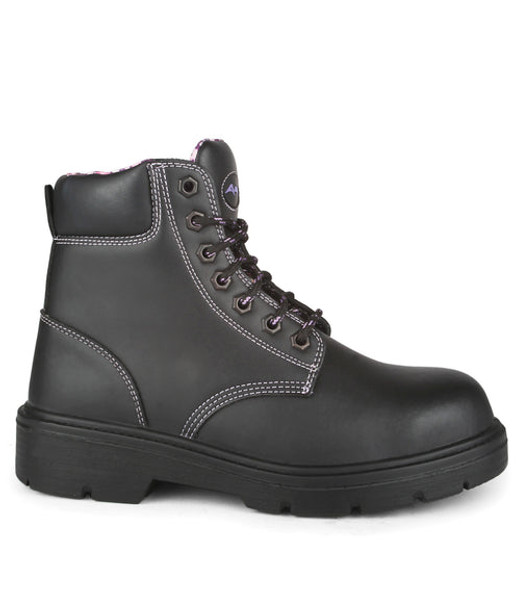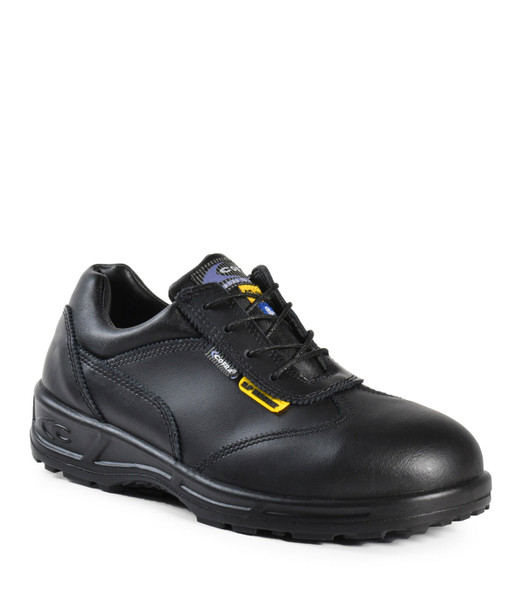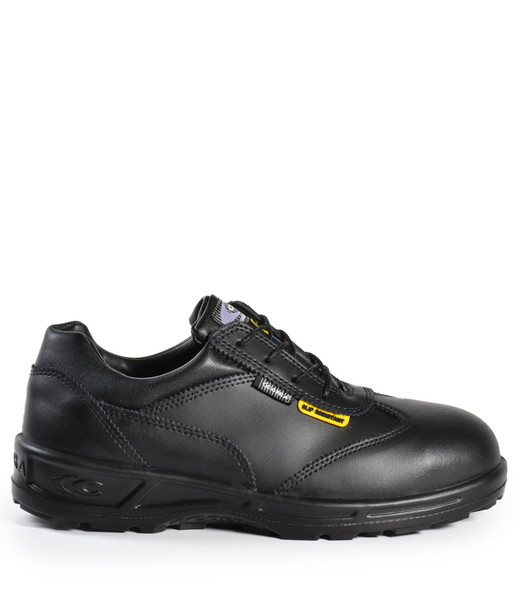
Women's Footwear
Women's Safety Footwear: Essential Protection for the Modern Workplace
Women's safety footwear combines specialized protection with female-specific design considerations to ensure proper fit, comfort, and safety in hazardous work environments. Unlike standard women's shoes, safety footwear features protective elements such as steel or composite toe caps, puncture-resistant soles, and slip-resistant treads to prevent workplace injuries. These specialized boots and shoes meet rigorous safety standards while addressing the unique anatomical needs of women's feet, offering narrower heel profiles and appropriate width-to-length ratios. Safety footwear for women comes in various styles, from traditional work boots to athletic-inspired safety shoes and even professional dress options, ensuring protection doesn't come at the expense of comfort or professional appearance.
Key Takeaways About Women's Safety Footwear Protection
- Women's safety footwear provides specialized protection with female-specific fit considerations for various workplace hazards.
- Safety certification ratings indicate the level of protection offered against impacts, compression, punctures, and electrical hazards.
- Modern women's safety shoes combine protection features with ergonomic design to prevent foot fatigue during long work shifts.
- Selection factors include hazard assessment, comfort features, proper sizing, and industry-specific requirements.
- Regular maintenance extends the lifespan of safety footwear while preserving protective capabilities and hygiene standards.
- Women's safety footwear styles range from industrial boots to professional-looking options suitable for various work environments.
- Safety standards like CSA, ASTM, and EN ISO certifications ensure footwear meets minimum protection requirements for workplace safety.
Common Applications and Use Cases for Women's Safety Shoes
Women's safety footwear serves essential roles across numerous industries where foot hazards are present. In construction and manufacturing environments, these specialized shoes protect against falling objects, compression hazards, and sharp debris that could penetrate standard footwear. Healthcare professionals benefit from slip-resistant women's safety shoes that provide protection during long shifts on potentially wet floors while maintaining comfort. Women's safety footwear options include specialized features for laboratory workers who need protection from chemical spills while maintaining a professional appearance.
In the energy sector, women's safety boots with electrical hazard protection safeguard against shock risks while providing necessary ankle support for uneven terrain. Warehouse and logistics personnel rely on lightweight yet protective women's safety shoes during extended periods of standing, walking, and lifting. Even culinary professionals utilize women's safety footwear with slip-resistant soles and puncture protection against dropped kitchen tools. The versatility of modern women's safety footwear extends to retail environments where employees face less severe but still significant hazards like impacts from merchandise handling and slippery floor conditions.
How to Choose the Right Women's Safety Footwear: Complete Buyer's Guide
Selecting appropriate women's safety footwear begins with identifying specific workplace hazards. Assess whether protection is needed against impacts, compression, punctures, electrical hazards, slips, or chemical exposure. Check safety ratings and certifications like CSA (Canadian Standards Association) or ASTM (American Society for Testing and Materials) that indicate tested protection levels. Safety shoes with appropriate certifications provide reliable protection for specific workplace hazards, with toe protection types ranging from steel to composite materials depending on job requirements.
Consider comfort features essential for long-term wear, including shock absorption, arch support, and breathable materials that reduce foot fatigue and moisture. Proper sizing is crucial for women's safety footwear, as ill-fitting shoes can cause discomfort and potentially compromise protection. Many manufacturers now offer women-specific lasts (foot molds) rather than scaled-down men's sizes. Industry experts recommend trying safety footwear late in the day when feet are slightly swollen, wearing work socks during fitting, and ensuring ample toe room while maintaining heel stability. For specialized environments, consider additional features like metatarsal guards, puncture-resistant plates, or chemical-resistant materials based on specific workplace requirements.
Essential Features of Women's Safety Footwear Explained
Safety toe caps form the cornerstone of protective footwear, available in steel, aluminum, or composite materials, each offering different benefits regarding weight, thermal properties, and metal detection concerns. Steel toes provide maximum impact protection while composite options offer lightweight alternatives that don't conduct cold or trigger metal detectors. Metatarsal guards extend protection beyond the toes to shield the upper foot from impacts, critical in environments with falling hazard risks.
Slip-resistant outsoles feature specialized tread patterns and rubber compounds designed to maintain traction on wet, oily, or uneven surfaces, significantly reducing fall risks. Puncture-resistant plates, typically positioned between the insole and outsole, protect against sharp objects penetrating through the bottom of the footwear. Many women's safety shoes include electrical hazard (EH) protection through non-conductive materials and construction methods that minimize electrical current flow. Comfort features specific to women's safety footwear include gender-specific cushioning, appropriate arch support, and anatomically correct fit proportions. Additional specialized features might include waterproofing membranes, chemical resistance, heat resistance, or cold weather insulation depending on the work environment requirements.
Professional and Industry Usage of Women's Safety Footwear
Professional environments maintain specific safety footwear requirements based on industry hazards and regulatory standards. Construction sites typically mandate footwear meeting CSA Green Triangle (Puncture resistant, Grade 1 toe protection) or ASTM F2413 standards with appropriate impact and compression ratings. Manufacturing facilities often require similar protection with added considerations for electrical hazard protection in areas with energized equipment. Cold climate footwear provides essential protection for outdoor workers facing extreme weather conditions while maintaining required safety features.
Healthcare settings prioritize slip resistance and ease of cleaning, with some specialized medical facilities requiring protection against sharps or heavy equipment. Laboratory environments demand chemical resistance alongside basic protection features, while food processing facilities require waterproof, easily sanitized safety footwear that meets food safety regulations. Workers in transportation and logistics benefit from lightweight safety footwear with shock absorption to reduce fatigue during long periods of movement. Professional usage often requires compliance documentation, with many workplaces implementing safety footwear programs that specify minimum protection standards, replacement schedules, and proper maintenance procedures to ensure ongoing protection effectiveness.
Industry-Specific Applications
Manufacturing Plants operate production lines with heavy machinery, moving parts, and occasional chemical exposure. These facilities require women's safety boots with comprehensive protection including impact-resistant toe caps, puncture-resistant soles, and often metatarsal guards. Athletic-style safety shoes with flexible construction allow for comfortable movement during long shifts while maintaining essential protection standards.
Healthcare Facilities face unique challenges including potential sharps hazards, biological contaminants, and wet floors. Medical professionals need lightweight women's safety footwear with slip-resistant outsoles and fluid-resistant uppers that can be easily cleaned and disinfected. Low-profile safety shoes that resemble professional footwear allow healthcare workers to maintain a professional appearance while receiving necessary protection.
Construction Sites present multiple hazards including falling objects, nail punctures, and uneven terrain. Women in construction benefit from ankle-supporting boots with Grade 1 toe protection, puncture-resistant plates, and electrical hazard protection. Durable waterproof materials with breathable membranes allow for all-weather protection during outdoor work while maintaining comfort.
Laboratory Environments contain chemical hazards, glass breakage risks, and precision equipment. Lab technicians require women's safety shoes with chemical-resistant uppers, closed designs to prevent spill infiltration, and non-marking soles. Lightweight, professional-looking options allow for comfort during long periods of standing while providing essential protection against specific laboratory hazards.
Warehouse Operations involve material handling, forklift traffic, and extended walking on concrete surfaces. Warehouse workers need women's safety footwear with shock-absorbing midsoles to prevent fatigue, slip-resistant outsoles for traction on various surfaces, and appropriate toe protection. Athletic-inspired safety shoes provide the flexibility and comfort needed for active warehouse roles while maintaining protection standards.
Food Processing Plants face wet floors, sharp tools, and temperature extremes during production. These environments require women's safety footwear with waterproof, sanitizable materials, slip-resistant outsoles designed for wet conditions, and insulation properties for cold rooms. Easy-clean surfaces and sealed seams prevent contamination concerns while providing necessary protection against workplace hazards.
Daily Wear Considerations When Choosing Work Boots for Women
Women's safety footwear must balance protection with practical everyday usability. Weight affects fatigue levels during extended wear, with lightweight materials becoming increasingly important for full-shift comfort without compromising protection. Breathability directly impacts foot health, with moisture-wicking linings and ventilation systems helping prevent blisters, odor, and fungal issues during daily use. Cold climate footwear with proper insulation provides comfort in extreme temperatures while maintaining necessary protective features.
Closure systems impact both convenience and customization of fit, with options including traditional laces, speed lacing systems, zippers, and elastic gores each offering different benefits. Women who transition between work sites or indoor/outdoor environments benefit from safety footwear with easy-clean surfaces and debris-shedding tread patterns. The break-in period varies between models and materials, with many modern safety shoes requiring minimal conditioning before achieving optimal comfort. Compatibility with orthotics or specialized insoles becomes essential for women with specific foot conditions or support needs. Additionally, the aesthetic appearance of safety footwear increasingly matters in customer-facing roles or environments where professional presentation remains important alongside safety requirements.
Work Boot Maintenance and Care: Extending Life and Performance
Regular maintenance not only extends the lifespan of women's safety footwear but also preserves critical protective features. Daily cleaning removes potentially corrosive substances and prevents material deterioration, with techniques varying based on upper materials. Leather safety boots benefit from periodic conditioning to prevent cracking while maintaining breathability and water resistance. Footwear cleaning accessories help maintain appearance and function of safety shoes through proper care procedures.
Proper drying techniques prevent damage after exposure to wet conditions, with room-temperature air drying recommended over direct heat that can compromise adhesives and materials. Insole replacement addresses interior wear before it impacts comfort and support, with many manufacturers offering compatible replacement insoles designed for their safety footwear. Experts recommend rotating between multiple pairs of safety footwear when possible, allowing complete drying between uses and reducing overall wear accumulation. Regular inspection should focus on critical safety elements including toe cap integrity, outsole tread depth, puncture plate positioning, and seam strength to identify when replacement becomes necessary for safety reasons rather than just appearance.
Standards and Safety Certifications for Lady's Protective Footwear
Understanding safety certifications ensures women's safety footwear meets appropriate protection standards for specific workplace hazards. In Canada, the CSA Group certifications use a color-coded system - Green Triangle indicates puncture resistance with Grade 1 toe protection, Yellow Triangle signifies puncture resistance with Grade 2 toe protection, and Blue Rectangle marks Grade 1 toe protection without puncture resistance. Metatarsal guard footwear offers additional protection against impacts to the upper foot area, important in environments with falling object hazards.
In the United States, ASTM F2413 establishes minimum requirements for design, performance, and testing of protective footwear, with specific codes indicating protection types. International standards include EN ISO 20345 in Europe and AS/NZS 2210 in Australia/New Zealand. Safety experts recommend selecting footwear that exceeds minimum standards for environments with multiple or severe hazards. Additional specialized certifications may apply for specific hazards like electrical protection (marked with White Rectangle CSA symbol or EH in ASTM), static dissipative properties (marked with Orange Rectangle CSA symbol or SD in ASTM), or chainsaw cut resistance. Certification markings typically appear on the footwear itself, allowing for easy verification of protective capabilities during safety inspections.
Troubleshooting Common Issues with Female Safety Shoes
Even well-designed women's safety footwear can present challenges requiring specific solutions. Heel slippage often indicates improper sizing or inadequate lacing techniques, resolved through proper fitting or aftermarket inserts that improve heel grip. Pressure points typically develop where footwear design doesn't accommodate individual foot anatomy, addressed through strategic breaking-in procedures or professional stretching of specific areas. Specialized insoles can improve comfort and fit of safety footwear while providing additional support for long work shifts.
Excessive weight fatigue can be mitigated by selecting composite materials rather than steel components where safety standards permit. Water intrusion indicates compromised waterproofing that may require specialized treatments or sealants to restore protection. Safety footwear that causes excessive foot heat may benefit from moisture-wicking sock materials or aftermarket insoles designed to improve air circulation. Premature sole wear patterns often reveal gait issues or improper footwear selection for specific work surfaces, potentially requiring orthotic intervention or different outsole compounds. For safety footwear consistently causing discomfort despite troubleshooting, professional fitting services can identify whether structural mismatches between foot anatomy and footwear design necessitate changing brands or styles altogether.
Investment Value Assessment for Women's Safety Boot Selection
Women's safety footwear represents a significant workplace safety investment requiring careful value consideration. Price ranges typically reflect protection levels, material quality, and comfort features, with entry-level options starting around $80 and premium models exceeding $200. Cost analysis should consider durability expectations based on work environment conditions and wear frequency, with higher upfront investments often delivering better value through extended service life. Shoe covers and boot covers can extend lifespan of safety footwear in certain environments by protecting against specific contaminants or hazards.
Replacement cycles depend on both visible wear indicators and invisible protection degradation, with most safety professionals recommending evaluation every six months and replacement at least annually for daily-wear situations. Economic impact extends beyond purchase price to include potential productivity improvements through reduced fatigue and greater comfort. Budget constraints can be addressed through timing purchases with seasonal sales or employer safety equipment allowances. The complete cost consideration should include potential accessory needs like specialized socks, insoles, or maintenance products that optimize both comfort and longevity. Safety footwear represents a critical protection investment where compromise can lead to both immediate injury risks and long-term health impacts, making informed value assessment essential to effective selection.
Quick Selection Checklist for Women's Safety Footwear
- Verify safety certification matches specific workplace hazards
- Ensure toe box accommodates natural foot spread during workday
- Measure foot late in day wearing work socks for accurate sizing
- Select weight-appropriate protection for job mobility requirements
- Calculate total ownership cost including replacement frequency
- Consider required break-in period before full-shift wear
- Inspect construction quality at stress points and seams
- Establish regular cleaning schedule based on work environment
- Product
- Qty in Cart
- Quantity
- Price
- Subtotal
-


Baffin | Woman's Storm (Toe) | Lightweight
Baffin Boots
$81.00Temperature Rating: -30ºC/-22ºF Women’s fit Light weight and flexible TR compound -30ºC/-22ºF felt liner 1” snow cuff Protective safety toe Durable outsole design CSA/ASTM approved$81.00 -


Prolady | 5'' Women's Nubuck Work Boots | Acton
Acton Boots
$129.99Description This 6'' leather work boot for women is CSA ESR certified and features a lightweight PU non-slip sole. It is affordable, comfortable and durable. Product details Height: 6’’ / 15,2 cm 2 mm leather...$129.99 -


Ingrid SD+ | Women's SD+ Leather Work Shoes | Cofra
Cofra Boots
$139.99DESCRIPTION Cofra certified SD+ (antistatic) work shoe for women, in water-repellent leather, with ultra-light non-slip Polyurethane (PU) sole and steel toe cap. PRODUCT DETAILS Height: 4’’ / 10 cm Water-repellent leather...$139.99 -


SPIDER X (Women's) CT CP ESR | Terra
Terra Boots
$144.00Water-resistant suede and nubuck leather upper with comfort-padded collar and tongue Moisture-wicking and abrasion-resistant lining CLEANFEET® odour-control treatment Reflective micro-printing on medial and lateral quarters Low-profi le...$144.00 -


PACER 2.0 (Women's) CT CP ESR | Terra
Terra Boots
$146.99Breathable microfiber and micro-mesh upper, sewn and punched eyelets Moisture-wicking and abrasion-resistant lining CLEANFEET® odour-control treatment Reflective 3M Scotchlite heel and vamp accents Athletic, high-traction industrial rubber outsole...$146.99 -


Slip Resistant Safety Shoes For Women PF636 | P & F Workwear
P & F Workwear
$147.99Description Genetic modifications have been carried out in our laboratories. Safety genes have been grafted onto a soft, feminine and lightweight espadrille. With its streamlined front, the P&F safety shoes will take on any worksite at top speed...$147.99 -


Daisy Women's Comfort-Lace Leather Safety Shoe | Steel Toe | Mellow Walk
Mellow Walk
$148.50Daisy Women's Comfort Lace Leather Safety Shoe | Steel Toe, CSA | Mellow Walk | Sizes: 5-11 (Half Size Options) *This product is Proudly Canadian! Offering a sleek design with top-of-the-line leather and DryFit...$148.50 -


Daisy Women's Leather Safety Sneaker | Steel Toe | Mellow Walk
Mellow Walk
$148.50Daisy Leather Safety Sneaker | Steel Toe, CSA | Mellow Walk | Sizes: 5-11 (Half Size Options) *This product is Proudly Canadian! The Daisy sneaker's unique zebra suede leather design will truly make you...$148.50 -


Daisy Women's Leather Slip-On Safety Shoe | Steel Toe | Mellow Walk
Mellow Walk
$148.50Daisy Leather Slip-On Safety Shoe | Steel Toe, CSA | Mellow Walk | Sizes: 5-11 (Half Size Options) *This product is Proudly Canadian! Offering a dressy safety shoe option, this Daisy easy slip-on shoe...$148.50 -


Jamie SD Safety Shoes
Mellow Walk
$148.50Women's Slip on steel toe SD+ safety shoes with slip resistant non marking dual density ousole.$148.50 -


Wmns Pacer 2.0 | Terra
Terra Boots
$149.99Athletically inspired in its design, the Pacer 2.0 brings agility and protection together in this women’s safety shoe. In addition to a high-traction rubber outsole, it has a lightweight shock absorbing EVA midsole and TPU arch support for...$149.99 -


Women's Pacer 2.0 SD35 | Terra
Terra Boots
$149.99Athletically inspired in its design, the Pacer 2.0 brings agility and protection together in this women’s safety shoe. In addition to a high-traction rubber outsole, it has a lightweight shock absorbing EVA midsole and TPU arch support for...$149.99 -


LadyFit | Women's Ultra Lightweight Athletic Work Shoes | STC
STC
$149.99DESCRIPTION Athletic safety shoe for women, made of highly breathable, ultra-lightweight, metal-free nylon, with dual density rubber non-slip sole, protective toe and lightweight composite anti-perforation sole. PRODUCT DETAILS Height: 4...$149.99 -


Maddy ESR Safety Shoes
Mellow Walk
$153.00Women's Leather lace up Steel toe ESR safety shoe. Slip resistant and non marking outsole. CSA Grade 1$153.00 -


Vanessa Women's Leather Safety Dress Pump | Steel Toe | Mellow Walk
Mellow Walk
$157.50Vanessa Leather Safety Dress Pump | Steel Toe, CSA | Mellow Walk | Sizes: 5.5-11 (Half Size Options) *This product is Proudly Canadian! Comfortable wearability paired with a dressy aesthetic flair!...$157.50 -


Maddy Women's Slip-On Leather Safety Boot | Metal-Free | Mellow Walk
Mellow Walk
$157.50Maddy Slip-On Leather Safety Boot | Metal-Free, CSA | Mellow Walk | Sizes: 5.5-11 (Half Size Options) *This product is Proudly Canadian! This Maddy Slip-On is a metal-free safety shoe that provides full...$157.50
